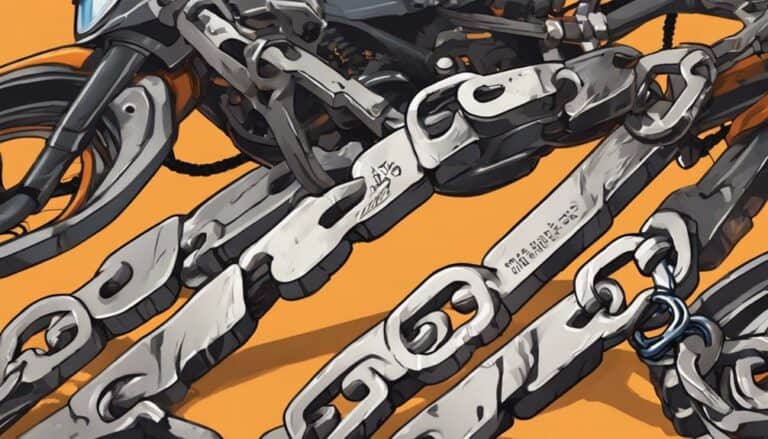When it comes to dirt bike chain sizes, think of it as finding the perfect puzzle piece to complete the picture of your bike's performance.
But, before you get to that satisfying click of a perfectly sized chain, there are important steps you must take to guarantee a smooth ride.
From understanding the importance of correct sizing to mastering the tools needed for the job, each detail plays a significant role in the best outcome.
So, are you ready to discover the secrets of achieving that seamless chain fit for your dirt bike's best performance?
Key Takeaways
- Choose the correct chain size to maximize power transfer and prevent premature wear.
- Use tools and steps to accurately measure and adjust chain length for optimal performance.
- Ensure compatibility with the dirt bike's specifications to maintain peak performance.
- Follow proper installation techniques, including tension adjustment and replacing chain and sprockets together.
Importance of Correct Chain Size
Confirming the correct chain size for your dirt bike is crucial to maximize power transfer efficiency and prevent premature wear on essential components. The chain size must align with the bike's specifications to maintain proper alignment and tension.
Without the right chain size, you risk chain slippage, leading to decreased performance and potential safety hazards. Different dirt bike models have specific chain size requirements, tailored to their engine displacement and power output. Failure to adhere to these chain specifications can result in accelerated sprocket wear and reduce the overall lifespan of the chain.
Tools Needed for Chain Sizing
To accurately size your dirt bike chain, you'll require specialized tools such as a chain breaker and a press and rivet tool for precise adjustments.
A chain breaker is important for shortening the chain to the correct size efficiently. Additionally, using a press and rivet tool can make the chain sizing process more accurate, making sure that the chain fits perfectly.
It's important not to substitute pliers for proper tools when adjusting the chain length, as this can lead to imprecise adjustments and potential safety hazards. Following the manufacturer's instructions for tool usage is important for successful chain sizing, guaranteeing that the process is done correctly.
Proper tools like a chain press ensure precise and efficient chain adjustment, making sure that your dirt bike operates smoothly. By using the right tools and following the recommended procedures, you can achieve the correct chain size without any issues.
Steps to Measure Chain Size
When measuring the chain size for your dirt bike, begin by identifying the pitch and width through precise measurements of the distance between specific components of the chain.
To measure the chain length, count the inner links and outer links. Inner links refer to the links with the pins, while outer links are the links with the rollers. Make sure to include both in your count for accuracy.
Additionally, inspect the chain and sprocket alignment to determine if it's time to replace a chain. Check the chain adjusters to confirm they're properly set to maintain tension.
Measure the distance from the rear axle to the front sprocket teeth to confirm proper chain length. Lastly, have the necessary tool to install the new chain readily available to streamline the replacement process.
Following these steps meticulously will contribute to the longevity and performance of your dirt bike chain.
Understanding Chain Size Compatibility
Understanding the compatibility of chain sizes is paramount for maintaining peak performance and longevity of your dirt bike. Here are some key points to take into account:
- Specific Chain Sizes: Different chain sizes such as 420, 520, and 525 are tailored to fit particular types of dirt bikes.
- Consult the Owner's Manual: The recommended chain size for your dirt bike can usually be found in the owner's manual, ensuring a precise fit.
- Proper Engagement with Sprockets: Using the correct chain size guarantees ideal engagement with the sprockets, promoting smooth operation.
- Preventing Issues: Selecting the right chain size is essential in preventing problems like skipping, premature wear, or damage to vital components of your dirt bike.
Tips for Proper Chain Installation
For ideal chain performance and longevity, precise installation is key. When installing a new chain on your dirt bike, start by confirming the chain is the correct size for your bike's sprockets. Begin by placing the new chain around the rear wheel sprocket and feeding it through the guides and rollers, making sure it sits correctly on both the inner and outer sides. Use a chain press to press fit the master link securely in place, making sure it's properly seated.
To reduce wear and prolong the life of your chain, make sure it has the correct tension. Adjust the chain adjusters to achieve best tension before cutting the chain to size. Remember to replace both the chain and sprockets together to ensure proper alignment and prevent premature wear. When cutting the chain to size, avoid using the axle as a cutting surface to prevent damage.
Conclusion
In conclusion, ensuring the correct dirt bike chain size is important for optimal performance. By using the right tools, measuring accurately, and following manufacturer guidelines, you can avoid installation problems and maintain your bike's efficiency.
Remember to replace sprockets when changing the chain and adjust chain adjusters before cutting to size. With proper chain sizing and installation, you can enjoy a smooth and safe ride on your dirt bike.

